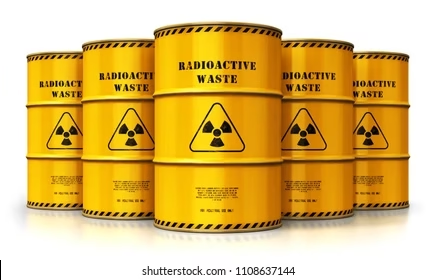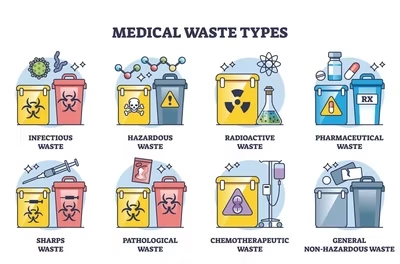
Introduction
- Handling and disposal of infected and dangerous radioactive materials is a highly specialised process that requires strict adherence to safety protocols, legal regulations, and industry standards.
- Radioactive materials, due to their ability to emit harmful radiation, pose significant risks to human health, wildlife, and the environment if not managed properly.
- The goal of safely handling and disposing of these materials is to minimise exposure to radiation, prevent contamination, and protect public and environmental safety.
- The process involves several key steps, including the proper identification and assessment of the risks associated with the material, safe handling using appropriate shielding and protective equipment, secure storage in designated facilities, and the final disposal of radioactive waste in ways that isolate it from the environment for the long term.
- Regulatory bodies such as the International Atomic Energy Agency (IAEA) and national agencies set stringent rules and guidelines to ensure that these practices are followed.
- Handling and disposal of infected and dangerous radioactive materials involve rigorous safety measures, compliance with legal and regulatory frameworks, and specialised procedures to protect human health, the environment, and the integrity of the materials being managed.
- Here’s a more detailed breakdown of the process:
हिंदी नोट्स के लिए यहां क्लिक करें
Preparation and Risk Assessment
-
Hazard Identification: Before handling radioactive materials, it’s crucial to identify the exact nature of the material, such as its isotopic composition, radioactivity, chemical reactivity, and biological effects. Each radioactive isotope has different properties that can affect the approach to safety and disposal.
-
Example: Isotopes like Uranium-235 or Plutonium-239 are highly radioactive and pose long-term risks, whereas Carbon-14 has a much lower risk due to its longer half-life.
-
-
Radiation Type: Radioactive materials can emit alpha, beta, or gamma radiation, each requiring different safety measures.
-
Alpha particles are the least penetrating and can be stopped by a sheet of paper or skin but are harmful if ingested or inhaled.
-
Beta particles can penetrate the skin and require more protective barriers (e.g., plastic or glass).
-
Gamma rays are highly penetrating and require dense shielding (e.g., lead or concrete) to protect from exposure.
-
-
Risk Assessment Tools: Use radiation detection tools (e.g., scintillation counters, Geiger counters) to assess the level of radioactivity in materials. The assessment should also evaluate environmental factors, potential contamination, and worker safety.
Handling Radioactive Materials
-
Radiation Protection Standards: According to organizations like the International Commission on Radiological Protection (ICRP), handling practices should focus on the ALARA Principle (As Low As Reasonably Achievable), aiming to minimize radiation exposure to workers, the public, and the environment.
-
Shielding: Materials like lead, concrete, and steel are used to shield workers from ionizing radiation. The type and thickness of shielding depend on the energy of the radiation emitted by the material.
-
Personal Protective Equipment (PPE):
-
Lead aprons, gloves, and face shields: To prevent external exposure.
-
Respirators: For protection against inhaling radioactive dust or gases.
-
Full-body suits: Especially in high-contamination zones or with highly radioactive materials, to limit contact exposure.
-
-
Decontamination: If radioactive contamination occurs on surfaces, clothing, or equipment, decontamination must be done immediately. This typically involves wiping surfaces with wet wipes, using chemical decontaminants, and employing special equipment like vacuum cleaners designed for radioactive materials.
Transportation
-
Regulated Transport: Transporting radioactive materials is subject to strict international and national regulations. The International Atomic Energy Agency (IAEA) and U.S. Department of Transportation (DOT) establish rules for the safe transport of radioactive materials, ensuring containment and preventing exposure.
-
Packaging: Radioactive materials must be placed in strong, tamper-proof containers that meet regulations for leak-tightness and radiation shielding. The packaging is often rated based on the type of material and its radioactivity level (Type A, Type B, etc.).
-
Type A packaging is used for materials with lower levels of radioactivity and is designed to withstand normal handling during transportation.
-
Type B packaging is used for more dangerous materials and is designed to withstand severe accidents, such as car crashes or plane crashes.
-
-
Transportation Vehicles: Specialised vehicles are required to transport radioactive materials safely. These vehicles are often equipped with radiation detection equipment to monitor any leakage or exposure during transport.
-
Emergency Protocols: In the event of a spill, accident, or leakage during transport, emergency procedures must be in place, including containment and notification of relevant authorities (such as fire and police departments).
Storage of Radioactive Materials
-
Designated Storage Facilities: Radioactive materials should be stored in specially designed facilities with strict environmental controls. These facilities must ensure that radiation is kept within safe limits and that radioactive materials are isolated from the public and the environment.
-
Types of Storage:

-
Short-term Storage: For materials that have a short half-life, temporary storage solutions such as shielded containers or vaults are used.
-
Long-term Storage: High-level radioactive waste (e.g., spent nuclear fuel) is stored in deep geological repositories, often hundreds of meters underground, to prevent radiation from reaching the surface.
-
-
Monitoring: Storage areas must be equipped with continuous radiation monitoring systems to detect any potential leaks. In addition, regular inspections should be conducted to ensure the integrity of containers and shielding.
-
Access Control: Only authorised personnel should have access to storage areas, and access should be monitored and logged.
Disposal of Radioactive Materials
-
Waste Classification: The disposal of radioactive waste is classified based on the level of radioactivity:
-
Low-Level Waste (LLW): Materials like contaminated gloves, clothing, and paper. These are typically stored for a short time to allow the radioactivity to decay before disposal in landfills.
-
Intermediate-Level Waste (ILW): Includes items like reactor components or chemical sludge. ILW requires shielding during storage and disposal.
-
High-Level Waste (HLW): Typically spent nuclear fuel or materials with very high radiation levels. HLW is stored in specialised containers or deep geological storage.
-
-
Decay Storage: For short-lived isotopes (those with a short half-life), decay storage is an option. The material is stored in a secure, controlled environment where it gradually becomes less radioactive over time.
-
Incineration and Burial: Some radioactive materials, like certain medical or industrial waste, may be incinerated (in specialized facilities) to reduce volume before burial in landfills designed to contain radioactivity.
-
Geological Disposal: High-level waste is disposed of in deep geological formations. This involves constructing specially designed disposal facilities deep underground in stable rock formations to isolate the waste for tens of thousands of years.
Environmental and Health Monitoring
-
Radiation Surveys: Ongoing monitoring is essential to ensure that radioactive materials do not escape their containment and that radiation levels remain safe for workers and the public. Radiation surveys are conducted at all stages: handling, transportation, storage, and disposal.
-
Environmental Monitoring: Monitoring radiation in the air, water, and soil surrounding storage or disposal sites is critical. This includes sampling and testing for radioactive contamination.
-
Health Surveillance of Workers: Personnel involved in handling radioactive materials undergo regular medical checks, including whole-body scans and blood tests, to detect early signs of radiation exposure. Dosimeters are worn by workers to monitor accumulated radiation doses.
Regulatory Compliance
-
National Regulations: Each country has its own regulatory authority for the control of radioactive materials. In the U.S., the Nuclear Regulatory Commission (NRC) and the Environmental Protection Agency (EPA) oversee nuclear safety and environmental protection.
-
International Regulations: The International Atomic Energy Agency (IAEA) provides global standards and recommendations for the safe handling, transport, and disposal of radioactive materials. Compliance with IAEA guidelines is necessary for international transport and trade in radioactive materials.
-
Records and Documentation: Accurate and detailed records must be maintained for every stage of the radioactive material lifecycle—from handling and transportation to storage and final disposal. These records are crucial for audits, legal compliance, and tracking the material’s journey from source to disposal.